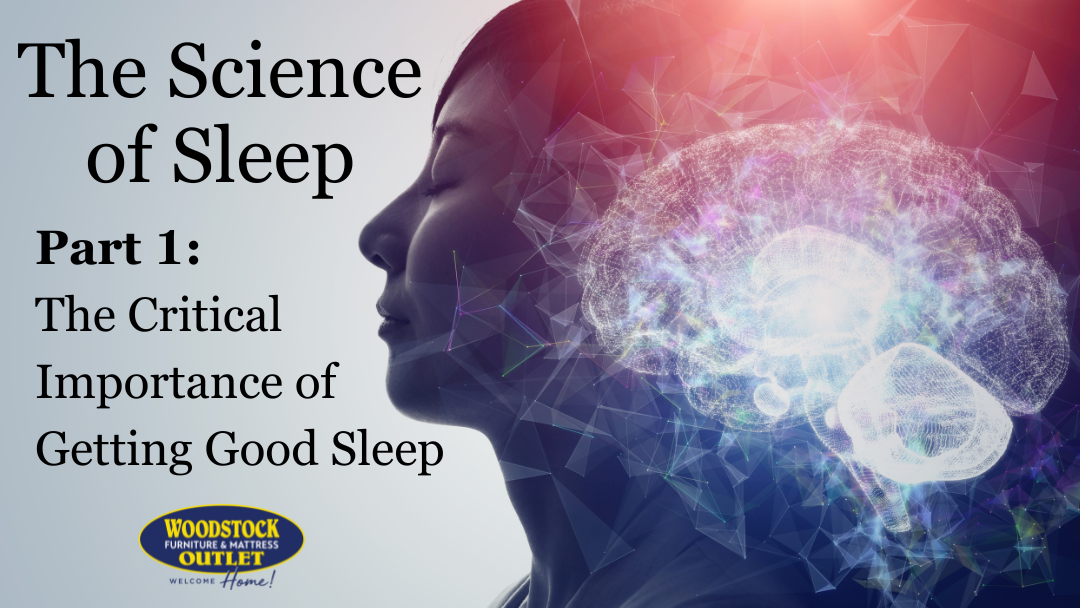Seemingly from birth, every single one of us have been bombarded with statements about the importance of sleep and how critical it is to our well-being. For most of us, this began in childhood with our parents. Sometimes these comments came with sweet lullabies. Other times, they came with exasperated pleas of “Don’t ask why, just please go to sleep!” If you were one of those kids always asking “why”, you’re in luck! Because today we’re finally uncovering the truth behind the why.
As it turns out, when it comes to the importance of sleep, our parents weren’t so wrong after all. In fact, there’s a mountain of scientific evidence that shows that getting quality sleep is vital to both physical and mental health. That’s why we put together this two-part series, The Science of Sleep.
Below, we’ll explore what it means to get good quality sleep, learn how sleep works to revitalize your body’s various systems, and ultimately, discover why sleep quality and quantity are both critical for your mind and body. By the end of this short series, it should be crystal clear to you whether you’re getting the best sleep possible, or if there are areas of improvement that can be solved with a simple shift in your sleep environment or nightly routines, or with a new mattress.

What Do We Mean When We Say “Good Sleep”?
There’s a persistent misconception when it comes to sleep. And it’s the idea that sleep quantity is the single most important factor when it comes to the sleep you’re getting. Think about it. How often do you hear people in your life talking about how much or how little sleep they’ve been getting lately? Yet very few discussions revolve around the quality of their sleep.
The truth is that both the quantity and quality of your sleep are incredibly important to your well-being. Here at Woodstock Furniture & Mattress Outlet, when our sleep experts talk about “good sleep” or “quality sleep”, we’re talking about both of these things.
For adults, it is recommended that you get between 7 and 9 hours sleep per night. But if that sleep is continually disrupted for any reason, you may still have muscle aches, joint pains, grogginess, mental fog, drowsiness, irritability and other issues when you wake up. Why? Because despite getting enough sleep, your body was unable to fully restore and repair itself from the day before.
Understanding Sleep Cycles & Their Critical Impact on Your Well-Being
Are you familiar with sleep cycles? The human sleep cycle is a natural, biological process through which our bodies rest and restore themselves. Each sleep cycle is made up of several different sleep stages and phases and takes between 90 and 120 minutes. With 7 to 9 hours of recommended sleep, that means you should ideally be getting through 4 to 6 cycles of sleep every single night. But what are these sleep stages and why are they important?

The sleep cycle consists of 2 sleep phases – REM sleep (which stands for “rapid eye movement” sleep) and NREM (or non-REM) sleep. These 2 phases are further broken down into 4 different sleep stages with Stage 1, Stage 2 and Stage 3 being NREM sleep and Stage 4 being REM sleep. Why do these stages matter? Well, each stage serves a unique function in the body which we’ll dive into below.
For our article on Sleep Cycles and the 4 Sleep Stages, feel free to read more here. However, for today’s purposes, we’re going to simplify things a bit by merging Stages 1 and 2 together. Let’s discuss Light Sleep, Deep Sleep, and REM Sleep, each of their functions, and how they contribute to your sleep quality.
Light Sleep Functions & Benefits (NREM Stages 1 & 2)
Sleep Stage 1 and 2 together make up your “light sleep”. Light sleep is important simply because it preps the body and mind for deeper, more restorative sleep. As such, it is in this phase that the body gradually transitions from being wide awake to being fully asleep. In a sense, light sleep is the foundation upon which your most important sleep is built upon.
From the time you close your eyes, it should take roughly between 5 minutes and 15 minutes to fall asleep. Any shorter (or longer) than this indicates a potential underlying issue with the sleeper, their sleep environment, their mattress, or all three.

During this stage, the eyes close, muscles begin to relax, and breathing, heart rate and brain activity slows. Additionally, the endocrine system releases increased amounts of the sleep hormone melatonin, helping sleepers drift easily into deeper sleep. To the surprise of those who “sleep hot”, this stage also leads to a 2 to 3 degree drop in core body temperature.
Light sleep typically makes up 50 to 60% of sleep time for adults – which translates to 3.5 to 5 hours if you’re getting the suggested 7 to 9 hours of total sleep. As the name suggests, sleepers are extremely susceptible to external stimuli such as light, sound and movement during this stage and can easily be woken up.
Deep Sleep Functions & Benefits (NREM Stage 3)
Thanks to the melatonin released during light sleep, at this point the sleeper can enter Stage 3, or “deep sleep”. Unlike light sleep which is far less specialized, deep sleep serves a very specific purpose – to repair and restore the muscles, bones and tissues within the body.
In order to make these tissue repairs happen, the sleeper’s body decreases the blood flow to the brain, and increases blood flow to the muscles. This increased blood flow carries with it a number of growth hormones released by the endocrine system.

This stage is also known as “slow wave sleep” because the frequency of brain waves slow way down. Since the brain is less active during this stage, there is very little movement from the body and external stimuli have very little effect on the sleeper. As we like to say, this is when you’re sleeping so hard that you’re “dead to the world”. If you are woken up during deep sleep, you can expect a great deal of grogginess and confusion.
Keep in mind that deep sleep only makes up 20 to 25% of the sleep most adults get every night (roughly 1.5 to 2 hours per night if you’re getting the recommended 7+ total hours of sleep). The physical recovery that occurs during this sleep stage is already critical for the body to function properly, but this shortened time frame makes it even more important to get deep sleep when you can.
REM Sleep Functions & Benefits (Stage 4)
As your body transitions out of deep sleep, it enters the final sleep stage, REM sleep. While light sleep eases you into deep sleep, and deep sleep heals the body’s tissues, REM sleep is all about the brain.
Brain activity during this stage is significantly increased, along with heart rate and blood pressure. As we mentioned above, REM stands for “rapid eye movement”. That’s because during this sleep stage, your brain activity practically goes off the charts causing your eyes to dart back and forth under your eyelids, similar to when you’re awake and looking around. In fact, sometimes the brain emits higher frequency waves during REM sleep than it does while awake!

It’s during this stage of sleep that sleepers have their most vivid dreams. And while sleepers are indeed susceptible to outside stimuli at this point, the brain temporarily paralyzes the arms and legs. With all the vivid dreaming, increased brain activity, and eyes flitting back and forth, most scientists believe that the brain paralyzes your limbs for your own safety so that you can’t act out those wild dreams.
So, what’s going on during this stage to make all the neurons go crazy? While REM sleep and the human brain are still not fully understood, we know that REM sleep is responsible for memory consolidation (i.e., converting short-term memory into long-term memory). We also know that it plays a huge role in mood regulation, as lack of REM sleep is linked to a number of neurotransmitter problems.
Much like deep sleep, you only get a small amount of REM sleep every night, between 20 and 25% of your total sleep amount. Making the most of this time is critical, because without sufficient REM sleep, your mental health, emotional health, cognition, and memory all suffer significantly.
The Consequences of Poor Sleep
Now that we understand the vital functions that REM sleep and deep sleep serve in particular, let’s talk about what happens when either the duration or quality of our sleep is insufficient. For instance, what happens when you don’t get enough sleep in general? How about when you are tossing and turning or otherwise constantly disrupted throughout the night?

First, let’s assume that you get the best quality of sleep in the world, but just not enough of it. Even so, keeping in mind that a proper night’s sleep should give you 4 or more sleep cycles, the result when you short-change the amount of sleep you get is the likely loss of entire cycles of sleep. This ultimately undermines your body’s ability to heal and rejuvenate itself.
Your first sleep cycle typically lasts around 90 minutes and each consecutive cycle of sleep is typically a tiny bit longer than the one before. As these cycles grow in length, REM sleep is the main recipient of this “extra” sleep time. This means that you typically get more deep sleep on the front end of the night, and more REM sleep on the backend.
So, if you’re getting way less than the recommended 7+ hours of sleep per night, most of that lost sleep comes out of the REM sleep column. The potential cost? Cognitive issues, inability to focus, impaired memory, irritability, mood changes, depression, anxiety, and a number of other symptoms linked to poor mental and emotional health.
Alternatively, let’s say that you’re getting plenty of sleep every night (on paper, at least), but you can’t seem to fall asleep and stay asleep. Unfortunately, you’re likely going to feel just as terrible as the folks who aren’t getting nearly enough rest. That’s because any time your sleep cycles are interrupted, they reset completely. So instead of getting much-needed deep sleep or REM sleep, you may get mostly light sleep instead. But a full 9-hours consisting of only light sleep is not sufficient rest for your mind or body.
Whether your sleep disruptors are aches and pains from inadequate support, acid reflux, snoring or sleep apnea, a swelteringly hot bedroom or mattress, or any number of other issues getting between you and a good night’s rest, they can prevent you from reaching the deep sleep needed to restore your body and the REM sleep needed to restore your mind.
Don’t Miss Part II! Join Us for the 3 Key Ways a Quality Mattress Can Improve Your Sleep – And Your Health!
We’ve established precisely why high quality sleep is necessary to live your best and healthiest life. We’ve also learned how your sleep cycles work to keep your mind and body running on all cylinders. With this information, you’re now equipped to assess whether or not you’re getting the quality sleep you desperately need to maintain proper physical and mental health.
Getting enough sleep but still waking up with achy muscles, sore joints, or other chronic pain? Do you spend your waking hours in a mental fog, irritable mood, or unable to focus? Does it take you less than 5 minutes or more than 15 minutes to fall asleep? If so, these are all signs that you likely aren’t getting good quality sleep.
Looking for solutions? Don’t miss The Science of Sleep, Part II where we’ll discuss the 3 key things your mattress must do for you in order to achieve a good night’s sleep. If your current sleep setup doesn’t pass this short checklist, your own sleep woes could be bedding or mattress related. Don’t miss it!
















